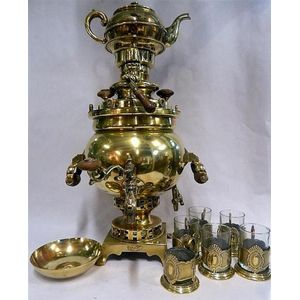French Bronze Figural Candelabra with Putto and Alabaster Support
You must be a subscriber, and be logged in to view price and dealer details.
Subscribe Now to view actual auction price for this item
When you subscribe, you have the option of setting the currency in which to display prices to $Au, $US, $NZ or Stg.
- Bronze - An alloy of copper and tin, traditionally in the proportions of about 9 parts of copper to 1 part of tin.
The discovery of bronze in Western Asia in the 4th century enabled people to create metal objects which were superior to those previoulsy possible because of its strength and hardness, and it has been used throughout the world for weapons, coins, tools, statuary and other decorative items.
It is very fluid in a molten state, and its hardness, strength when set, and non-corrosive properties makes it most suitable for casting sculpture. - Alabaster - Alabaster is soft natural stone used for statuary, with a similar appearance to marble, but easier to work with. As it is softer than marble, an item made from alabaster can be scratched with a metal object, and an alabaster item does not polish to a high surface gloss like marble.
Alabaster objects can be semi-translucent. Alabaster occurs in a pure white form and also with veining from dirt. Colours vary from white through yellow and pink to brown. The veining is usually green or black but can be multicoloured.
Being semi-translucent, alabaster is often used for the bowls of figural lamps, with the figure itself being either alabaster or marble. - Putto / Putti / Amorino / Amorini - A putto (plural: putti) or amerino (plural: amerini) is a cherub or cupid frequently appearing in both mythological and religious paintings and sculpture, especially of the Renaissance and Baroque periods and later used as a decorative element in the design of furniture, ceramics, statuary etc. They are usually depicted as chubby males, or of indeterminate gender, often with wings. Their depiction may represent an association with love, heaven, peace or prosperity.
This item has been included into following indexes:
-
candelabra / candelabrum
- French 163
- ormolu and bronze 191
- pairs and garnitures 519
- candlesticks, types - French 162
Visually similar items

A Russian brass samovar with six tea holders and five tea glasses, plus teapot

A large ornate cast iron hall stand with green and gold patina of French style, modelled with a young slave girl in chains, the top section modelled with scrolling leaves and flowers and supporting seven lion mask coat hooks, the umbrella stand base with t

A bronze Cupid figure, early 20th century, the cast winged figure with a bow standing upon a celestial globe and raised upon an integral circular base. Height 85 cm

Japanese silver and white metal shibayama lidded urn, with polychrome enamel decoration, flanked by shibayama panels depicting flowers and birds with coral, mother-of-pearl and ivory embellishments, with two dragon handles, the lid surmounted by an eagle,
